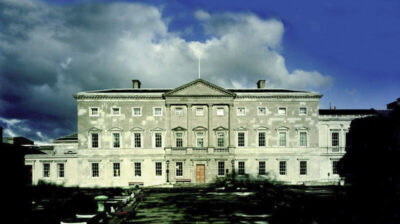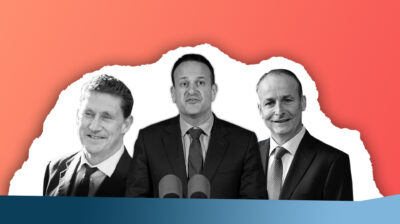Labour vs Sinn Féin: what’s the difference?
Learn more about Ireland’s largest left-wing parties
Written by spunout
News
Information about the latest news and opportunities.

The Labour Party and Sinn Féin are two of the larger left-wing parties in Ireland, but have major differences from one another when it comes to their history and approach to politics.
Sinn Féin is a political party that is active in both the North and the Republic of Ireland, whereas the Labour Party are only active in the Republic.
What is the difference between Sinn Féin and the Labour Party?
Although Labour and Sinn Féin are not as big as Fianna Fáil or Fine Gael, they can have a major impact on how the country is run due to the formation of coalition governments. A coalition is where a larger party, such as Fianna Fáil or Fine Gael, will join with a smaller party or parties to form a government in order to secure their power.
The last coalition government in the Republic was between Fine Gael and Labour and lasted from 2011 to 2016. During this time Labour supported austerity policies (economic policies where the government reduces its spending during a recession) as part of the coalition government. As a result of this, they lost large numbers of seats in the 2016 election down from 37 to seven.
Sinn Féin has yet to form part of a coalition government in the Republic but was part of the government of Northern Ireland, the Northern Irish Executive, between 2007 and 2016. The Northen Irish Executive was a form of power-sharing government which was formed between mainly the DUP and Sinn Féin, it collapsed in 2017 and has not reformed since.
Recent General Elections
After the 2020 General Election, Sinn Féin won 37 seats in Dáil Éireann, while Labour won six seats. Both parties are currently in Opposition in the Republic. In 2017 Sinn Féin won 27 seats in the Northern Irish Assembly and seven seats in the United Kingdom House of Commons. Sinn Féin MPs elected to the House of Commons follow a policy of abstentionism, meaning they don’t vote, speak or attend in protest at Northern Ireland’s status as part of the UK. There are four Sinn Féin members of the European Parliament, three representing the Republic of Ireland and one representing Northern Ireland. Labour does not currently have any seats in the European Parliament.
Where did these parties come from?
Labour and Sinn Féin have two different political origins rooted in Irish history.
The Labour Party
The Labour Party was founded in 1912 and aimed to represent working-class people and particularly members of the trade union movement. Over time, the party’s focus expanded to include social issues such as women’s rights and equality for LGBTI+ people. Labour has participated in eight coalition governments in the history of the Republic, usually with Fine Gael.
A coalition is formed when a larger party, such as Fianna Fáil or Fine Gael, fail to win enough seats to form a Government, and so they join up with one or a number of smaller parties or independents in order to make up the numbers to form a government and secure their power.
The last coalition government between Fine Gael and Labour and lasted from 2011 to 2016. During this time Labour supported austerity policies (economic policies where the government reduces its spending during a recession) as part of the coalition government. As a result of this, they lost large numbers of seats in the 2016 election down from 37 to seven.
Sinn Féin
The modern Sinn Féin party came into existence in 1970 and was originally mostly active in Northern Ireland. The party was closely linked with the Provisional IRA and believed in uniting Northern Ireland and the Republic through a mix of violence and political activism. In the 1990s, Sinn Féin ended its support for violence and joined the new Northern Irish Executive (Government) set up under the Good Friday Agreement of 1998.
Since then, Sinn Féin has become the second-largest party in Northern Ireland and has grown in popularity in the Republic. They have yet to form part of a coalition government in the Republic but was part of the government of Northern Ireland, the Northern Irish Executive, between 2007 and 2016. The Northern Irish Executive was a form of power-sharing government which was formed between mainly the DUP and Sinn Féin. It collapsed in 2017 and was reformed in January 2020.
What is the difference between Labour and Sinn Féin?
Both parties identify as left-wing, meaning they are in favour of stronger workers’ rights, a more equal distribution of wealth, and higher levels of public spending than parties of the right. Beyond this, there are a number of similarities and differences between the two parties.
What are the similarities between Labour and Sinn Féin?
Labour and Sinn Féin agree on a number of important issues.
- Both parties campaigned for a ‘Yes’ vote in the referendums on Marriage Equality and Repeal of the Eighth Amendment
- Both parties support policies like a higher minimum wage and increasing public spending on housing and healthcare
- Both parties have supported lowering the voting age to 16
What are the differences between Labour and Sinn Féin?
There have also been major points of disagreement between the two parties:
Water charges
Labour supported the introduction of water charges in 2014, while Sinn Féin opposed them.
The European Union
Labour has backed every referendum on greater European integration, whereas Sinn Féin has been more Eurosceptic (though still supports Ireland’s membership of the EU).
Austerity
During the period 2011-2016, Labour supported a series of austerity budgets while in coalition with Fine Gael. Sinn Féin opposed these austerity policies.
Austerity is an economic policy which involves the government reducing its public spending. This means cuts to public services like social welfare, as well as cutting funding to various Government departments and state-run organisations, like education or the HSE.
Northern Ireland
Sinn Féin are currently calling for a ‘border poll’ or public vote on a United Ireland, while Labour has said more work must first be done to convince Northern Irish unionists who currently want to remain part of the United Kingdom.
Relations between the parties
Although the parties have a number of similar policies, Labour and Sinn Féin have not yet worked together in government on a national level, and there is a considerable gulf between the two parties based on their historic disagreements.
Labour has long been critical of Sinn Féin for its support of IRA violence during the Troubles in Northern Ireland, and for not supporting a peaceful solution to the conflict from an earlier time. Sinn Féin, on the other hand, has been highly critical of Labour’s decision to support austerity policies between 2011 and 2016, which they say disproportionately harmed the poor.
Who else can I support?
Sinn Féin and the Labour Party are just two options among a wide range of political choices for Irish voters. Parties like the Greens, Solidarity, People Before Profit and the Social Democrats all offer other alternatives to the “big two”, and it’s up to each individual voter to decide which (if any) of the existing parties deserve their support.
Learn more about:
- The difference between Fianna Fáil and Fine Gael
- The Green Party, Social Democrats, and Solidarity-People Before Profit
- The Independent Alliance and Independents 4 Change: what’s the difference?
- How to join a political party
Need more information?
We are here to answer your questions and talk through your options. Our online chat service is for 16 to 25 year olds and is available Monday to Friday, 4pm to 8pm. Chat to us now about your situation.
- Chat now to a trained Youth Information Officer
- Or leave us a message and we will email you back






